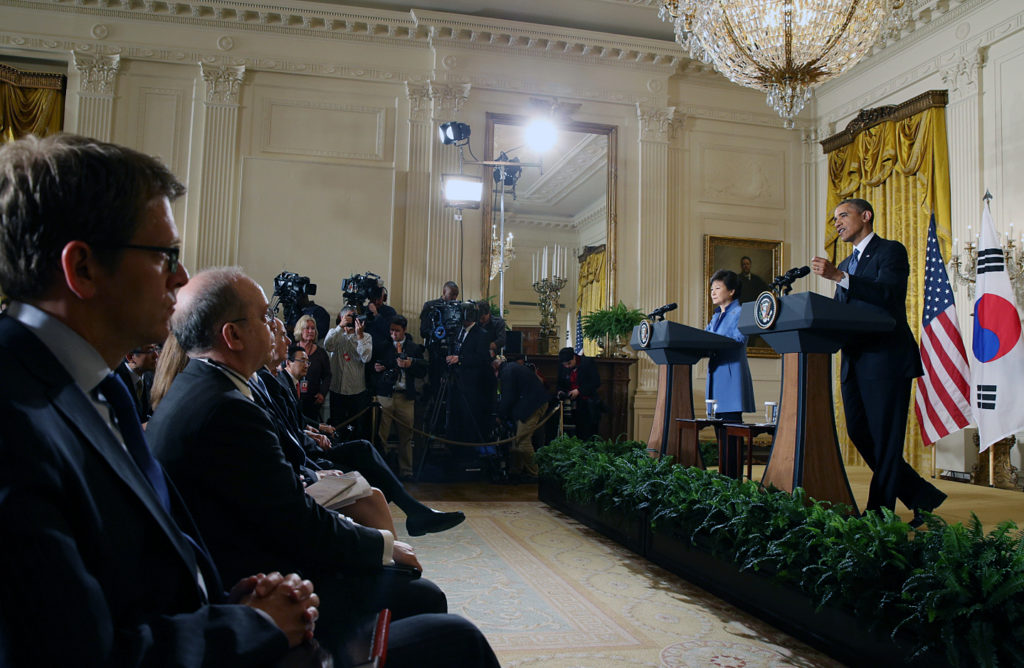The Peninsula
Laying the Foundation for Innovation and Economic Growth in Korea and the United States
Published September 10, 2013
Category: South Korea

By James W. Fatheree
A recent KEI annual seminar provided the U.S. Chamber/U.S.-Korea Business Council (USKBC) with an opportunity to provide our perspective on the economic priorities of both the Obama and Park administrations–where these priorities line up and ways in which our governments and business communities can work together to support policies that foster economic growth and job creation.
Korea and the United States both enjoy a number of competitive advantages – high innovation capabilities, educated and sophisticated workforces, and cutting-edge technologies in key areas, such as information, health care, and energy. These characteristics make both economies among the most innovative and dynamic in the world.
However, both countries also face systemic challenges. In the United States, these include high levels of public debt, rising entitlement spending, income inequality, and political dynamics that are making it difficult to address these problems. In Korea, the challenges stem from recent currency movements – particularly in the Japanese yen – high wages, high youth unemployment, income inequality, and imbalances between the Chaebol and other segments of the economy.
To their credit, the economic priorities of both the Park and Obama administrations seek to address these challenges and spur economic growth through a mix of economic policies that provides support for traditional industries, such as manufacturing, as well as for Small and Medium-sized Enterprises (SMEs). Ultimately, the goal is the same – increasing jobs in Korea and the United States.
Both administrations are focused on increasing innovation, particularly by devoting more resources to the ICT, science, and technology fields. Presidents Park and Obama both understand that new science and technology discoveries and applications are critical to sustained economic growth, and increasing productivity, competitiveness, and job creation. President Park has made measures to support Korea’s “creative economy” a cornerstone of her economic growth policy and has established a new innovation ministry (Ministry of Science, ICT, and Future Planning) focused on promulgating policies and regulations to advance innovation. President Obama has focused on clean energy technology and has emphasized not only resources but also policies that support the development of clean energy industries and new manufacturing techniques.
While it is laudable to be forward-looking and dedicated to trying to steer our economies toward future growth, there is also a risk of government overreach. It is important, therefore, to promote innovation with an eye on the basics – regulatory, tax, labor, trade, and other policies that determine fundamental business conditions and shape the competitive environment in which Korean and U.S. companies must operate domestically. If these basic conditions are not right, no amount of industry/technology targeting will achieve the desired results. Worse, the wrong policy mix can stymie private sector innovation if policymakers and regulators are unable to keep pace with technological advancements and new innovations. This is a particular challenge in fast-moving innovation-based industries, such as medical and information technology.
Given that both governments want to increase the growth of SMEs, it is important to focus on the things that are most conducive to the growth of small and mid-sized companies. Recent data on the U.S. economy indicate that it is new companies, not necessarily just small ones that create the most new jobs. For SMEs, particularly start-ups, getting the basics right is perhaps even more important for growth. Business conditions that support SME growth – low taxes and/or lengthy carry-over periods for net operating losses, smart regulatory policies that protect public safety without imposing high hurdles that can limit entry/exit or new product development, minimal mandates that do not restrict flexibility and add costs – are even more critical than for larger companies since most SMEs do not have much financial cushion for extra costs.
Both administrations understand the importance of expanding trade and seeking growth outside of the domestic market, as innovation thrives in open markets with open systems and through open trade platforms. In this regard, full and faithful implementation of the U.S.-Korea Free Trade Agreement is an essential element for enhanced U.S.-Korean economic collaboration and innovation. Successful conclusions of the Trans-Pacific Partnership (TPP) and Trans-Atlantic Trade and Investment Partnership (TTIP) negotiations will further support trade and innovation in the United States. For similar reasons, Korea should continue its aggressive agenda to expand trade.
The Obama and Park administrations have a great opportunity to work together over the next few years to expand collaboration in ways that will fuel innovation in both economies. Getting the basics right in both countries is a critical foundation for creating more involved programs that will support future growth in specific sectors and industries.
James W. Fatheree is the Executive Vice President of the U.S.-Korea Business Council. The views expressed here are the authors alone.
Photo from Korea.net’s photostream on flickr Creative Commons.
